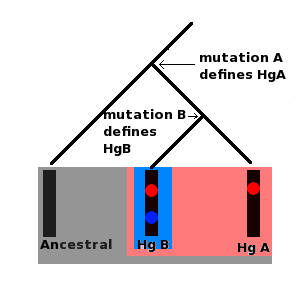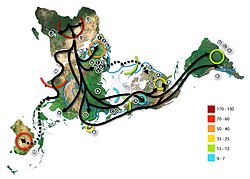Haplogroup

At some time, a mutation occurred in the ancestral molecule, mutation A, which produced a new lineage. This is haplogroup A, defined by mutation A.
Later, a new mutation, mutation B, occurred in a person carrying haplogroup A. Mutation B defined haplogroup B. Haplogroup B is a subgroup of haplogroup A. Both haplogroups A and B are subgroups of the ancestral haplogroup
A haplogroup is a group of single chromosomes, or single DNA strands, which share a common ancestor. They have the same mutation in all versions.[1]
Haplogroups show deep ancestral origins dating back thousands of years.[2]
In human genetics, the haplogroups usually studied are Y-chromosome (Y-DNA) haplogroups and mitochondrial DNA (mtDNA) haplogroups. Both can be used to define genetic populations. Y-DNA is passed only from father to son, while mtDNA is passed only from mother to children. Neither recombines, and thus Y-DNA and mtDNA change only by chance mutations with no intermixture between parents' genetic material.
Haplogroup Media
Map of human haplotype migration, according to mitochondrial DNA, with key (coloured) indicating periods in numbered thousands of years before the present.
Related pages
References
- ↑ The technical way of saying this is: they have the same single nucleotide polymorphism (SNP) mutation in all haplotypes.
- ↑ The International Society of Genetic Genealogy see Haplogroup definition in DNA--NEWBIE GLOSSARY [1]


